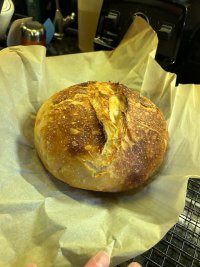You are using an out of date browser. It may not display this or other websites correctly.
You should upgrade or use an alternative browser.
You should upgrade or use an alternative browser.
Homemade Bread Thread
- Thread starter deadfall
- Start date

Help Support Homebrew Talk:
This site may earn a commission from merchant affiliate
links, including eBay, Amazon, and others.
user 246304
Well-Known Member
- Joined
- Aug 24, 2017
- Messages
- 8,290
- Reaction score
- 9,850
This is a "Pfalzer Krustenbrot," a very traditional regional sourdough from the German Palatinate. It´s a 50:50 mix of rye and wheat flours. From the book Heimatbrote by German physician Dr. Björn Hollsteiner, der brotdoc | Gesundes Brot aus meinem Ofen …, author, and, I´m honored to call, friend.
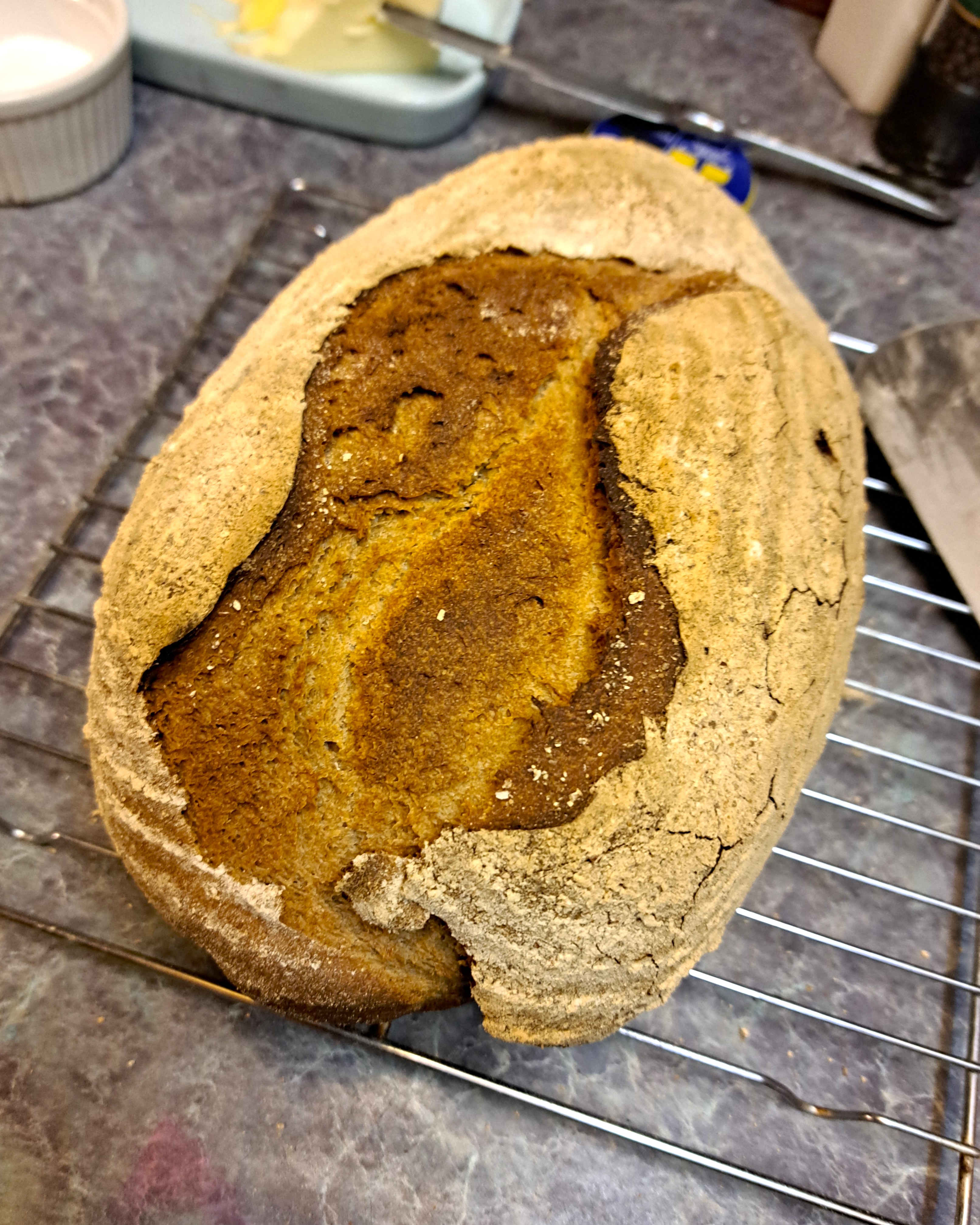



Hey Gad, it's been a while. I hope you're well. And nice bread!
user 246304
Well-Known Member
- Joined
- Aug 24, 2017
- Messages
- 8,290
- Reaction score
- 9,850
Hey Kent, wonderful to see you man! Yep, been a long while. I hope things are going well for you. I stopped brewing - health was really bad, part of it due to underlying condition(s) that won't be cured but were poorly understand, until a few years ago. I was able to finally turn to training and lost a lot of weight (275 or so at its worst, down to 220-224 for years now), so just don't drink beer like I used to. But you know, I've always missed brewing itself and crazily this post-retirement gig at our lbs lit a fire, so just starting back. Can't wait to brew again.Hey Gad, it's been a while. I hope you're well. And nice bread!
Thanks for posting and for the kind words buddy. Great to see you.
Has anyone used kefir in place of yeast or a sourdough starter? Online sources suggest 1 cup each flour and kefir, fermented for three days prior to baking.

$22.00 ($623.23 / Ounce)
AMZLMPKNTW Ball Lock Sample Faucet 30cm Reinforced Silicone Hose Secondary Fermentation Homebrew Kegging joyful
无为中南商贸有限公司

$53.24
1pc Hose Barb/MFL 1.5" Tri Clamp to Ball Lock Post Liquid Gas Homebrew Kegging Fermentation Parts Brewer Hardware SUS304(Gas MFL)
Guangshui Weilu You Trading Co., Ltd

$53.24
1pc Hose Barb/MFL 1.5" Tri Clamp to Ball Lock Post Liquid Gas Homebrew Kegging Fermentation Parts Brewer Hardware SUS304(Liquid Hose Barb)
yunchengshiyanhuqucuichendianzishangwuyouxiangongsi

$44.99
$49.95
Craft A Brew - Mead Making Kit – Reusable Make Your Own Mead Kit – Yields 1 Gallon of Mead
Craft a Brew

$7.79 ($7.79 / Count)
Craft A Brew - LalBrew Voss™ - Kveik Ale Yeast - For Craft Lagers - Ingredients for Home Brewing - Beer Making Supplies - (1 Pack)
Craft a Brew

$76.92 ($2,179.04 / Ounce)
Brewing accessories 1.5" Tri Clamp to Ball Lock Post Liquid Gas Homebrew Kegging Fermentation Parts Brewer Hardware SUS304 Brewing accessories(Gas Hose Barb)
chuhanhandianzishangwu

$49.95 ($0.08 / Fl Oz)
$52.99 ($0.08 / Fl Oz)
Brewer's Best - 1073 - Home Brew Beer Ingredient Kit (5 gallon), (Blueberry Honey Ale) Golden
Amazon.com
![Craft A Brew - Safale S-04 Dry Yeast - Fermentis - English Ale Dry Yeast - For English and American Ales and Hard Apple Ciders - Ingredients for Home Brewing - Beer Making Supplies - [1 Pack]](https://m.media-amazon.com/images/I/41fVGNh6JfL._SL500_.jpg)
$6.95 ($17.38 / Ounce)
$7.47 ($18.68 / Ounce)
Craft A Brew - Safale S-04 Dry Yeast - Fermentis - English Ale Dry Yeast - For English and American Ales and Hard Apple Ciders - Ingredients for Home Brewing - Beer Making Supplies - [1 Pack]
Hobby Homebrew

$176.97
1pc Commercial Keg Manifold 2" Tri Clamp,Ball Lock Tapping Head,Pressure Gauge/Adjustable PRV for Kegging,Fermentation Control
hanhanbaihuoxiaoshoudian

$58.16
HUIZHUGS Brewing Equipment Keg Ball Lock Faucet 30cm Reinforced Silicone Hose Secondary Fermentation Homebrew Kegging Brewing Equipment
xiangshuizhenzhanglingfengshop

$20.94
$29.99
The Brew Your Own Big Book of Clone Recipes: Featuring 300 Homebrew Recipes from Your Favorite Breweries
Amazon.com

$719.00
$799.00
EdgeStar KC2000TWIN Full Size Dual Tap Kegerator & Draft Beer Dispenser - Black
Amazon.com

$479.00
$559.00
EdgeStar KC1000SS Craft Brew Kegerator for 1/6 Barrel and Cornelius Kegs
Amazon.com

$33.99 ($17.00 / Count)
$41.99 ($21.00 / Count)
2 Pack 1 Gallon Large Fermentation Jars with 3 Airlocks and 2 SCREW Lids(100% Airtight Heavy Duty Lid w Silicone) - Wide Mouth Glass Jars w Scale Mark - Pickle Jars for Sauerkraut, Sourdough Starter
Qianfenie Direct
Sounds like something @bernardsmith would know about
- Joined
- Feb 19, 2017
- Messages
- 979
- Reaction score
- 1,238
What beer yeast(s) would folks here recommend for bread baking?
Some random websites claim Nottingham is a good one and makes the bread smell like oatmeal (in a good way). I have Notty in stock, so will probably try that. I have another 20+ beer yeasties in the library, so checking the experienced wisdom here.
Some random websites claim Nottingham is a good one and makes the bread smell like oatmeal (in a good way). I have Notty in stock, so will probably try that. I have another 20+ beer yeasties in the library, so checking the experienced wisdom here.
@kmarkstevens : None. Every attempt I have made to use beer yeast for bread ended up tasting like bad banana bread, and I don't think we had a banana in the house the days I made them.
Good luck.
Good luck.
Apparently, there was a time in history that didn’t have bakers yeast and brewers yeast, and brewing yeast was used for leavening breads. Belgian liege waffles for example are often still made with ale yeast. I did this about a year ago. They didn’t taste or smell like bananas. So, yes you can. The process may take longer compared to fast dry baker’s yeast, and unless you have a surplus/propagate your yeast it costs more than bread yeast. So you could use that English yeast for an “English style” bread, German yeast for German breads etc. Have fun and please let us know how it turns out.What beer yeast(s) would folks here recommend for bread baking?
Some random websites claim Nottingham is a good one and makes the bread smell like oatmeal (in a good way). I have Notty in stock, so will probably try that. I have another 20+ beer yeasties in the library, so checking the experienced wisdom here.
- Joined
- Feb 19, 2017
- Messages
- 979
- Reaction score
- 1,238
Fun fact, Fritz Maytag, the person that saved Anchor Steam the first time, brewed with 5 Star yeast for a period of time. Fascinating interview, and you can listen to the interview here: Master Brewers Podcast - Fritz Maytag

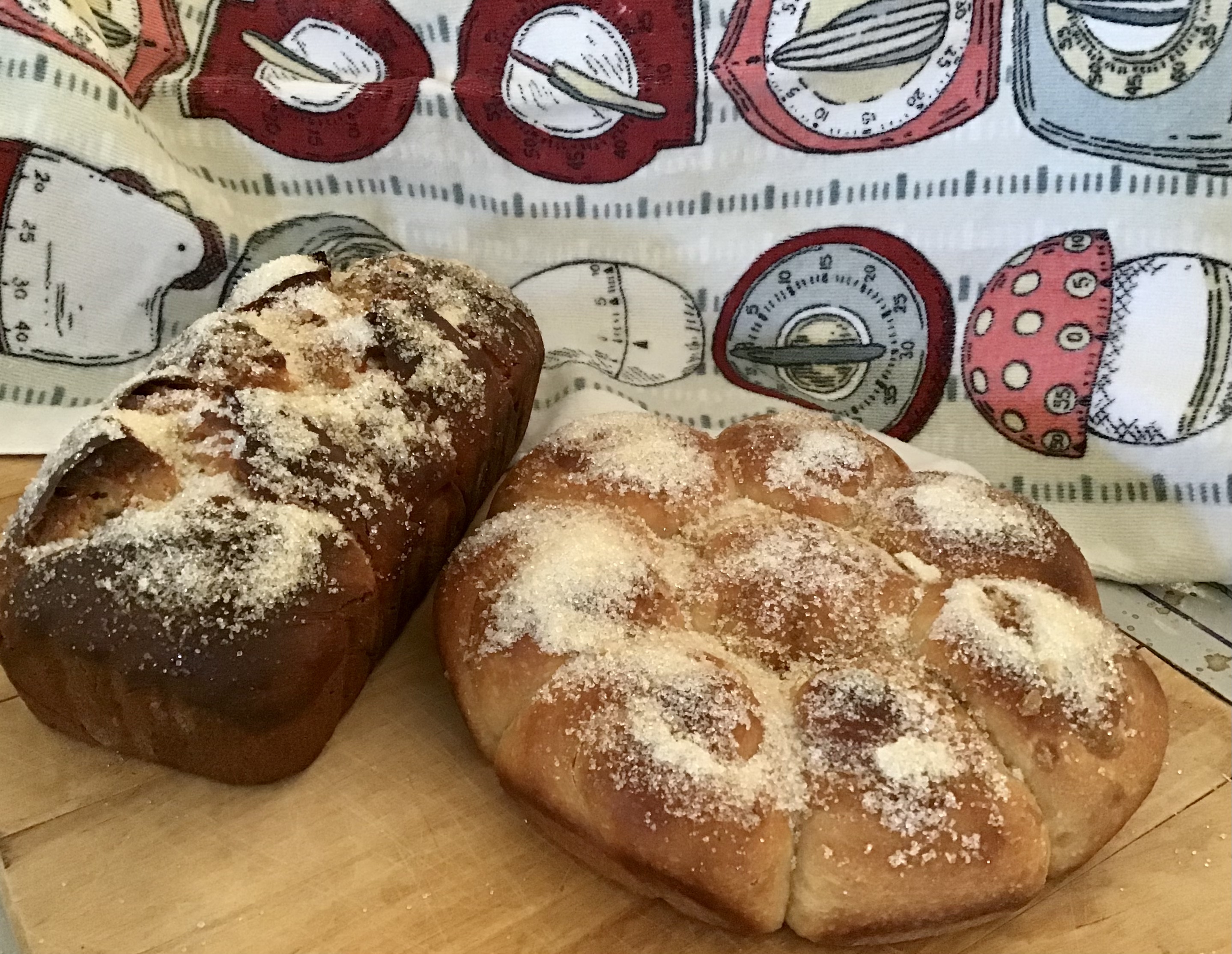
Enriched dough with cardamom for Finnish cardamom coffee bread in the bucket over 2 days to prove it needed a high temperature around 90F. Pretty tasty even though the loaf got dark.
I think my kefir bread starter experiment is a fail. 72 hours in my mixture is only just starting to show activity. A few bubbles and nothing else...


- Joined
- Feb 19, 2017
- Messages
- 979
- Reaction score
- 1,238
Nottingham on the first try made a nice white rustic bread loaf. My kids and I couldn't find any oatmeal or any other non bread (banana) flavors. I didn't fully do a side by side comparison with quick rise yeast or regular baking yeast. Maybe I will.What beer yeast(s) would folks here recommend for bread baking?
Some random websites claim Nottingham is a good one and makes the bread smell like oatmeal (in a good way). I have Notty in stock, so will probably try that. I have another 20+ beer yeasties in the library, so checking the experienced wisdom here.
I've got a homemade sourdough cultured from Bob's Red Mill whole wheat that is getting pretty sour after two weeks and rises well. (The Bob's Rye flour home caught sourdough was nasty.). And I mixed the wild caught Bob's whole wheat with Nottingham for a try tomorrow.
What I think is one of the greatest things on the internet is Friends of Carl sourdough starter. Carl's ancestors took a wagon train on the Oregon trail in 1847, and used this sourdough. Supposedly, this starter has been feed and is a direct unbroken descendent of the yeast that came over the trail. For a seal addressed stamped envelope, a "friend of carl" will send you some dried starter. It makes great yeast, sour, and ferments well.
Origin story: The history has been asked for. All I know is that it started west in 1847 from Missouri. I would guess with the family of Dr. John Savage as one of his daughters (my great grandmother) was the cook. It came on west and settled near Salem Or. Doc. Savage’s daughter met and married my great grand father on the trail and they had 10 children. It was passed on to me though my parents when they passed away. I am 76 years old so that was some time ago. I first learned to use the starter in a basque sheep camp when I was 10 years old as we were setting up a homestead on the Steens Mountains in southeastern Oregon. A campfire has no oven, so the bread was baked in a Dutch Oven in a hole in the ground in which we had built a fire, placed the oven, scraped in the coals from around the rim, and covered with dirt for several hours. I used it later making bread in a chuck wagon on several cattle drives - again in southeastern Oregon.
Not sure when Carl left for the great sourdough bakery in the sky, but guess the early 2000's. I heard of it in the early 2000's and a friend of Carl kindly sent me a free starter to China, where I kept it going for about 5 years. I got a second batch during covid, and that too finally died off. This thread, and trying Notty as a baking yeast got me off my keister to not only send for a new starter, I also included a $20 donation this time in the envelope.
Anyhoo, if Frieds of Carl Sourdough starter has captured your imagination, then send a stamped envelope, wait a month or two and then check it out.
A couple mini-boules of caraway pumpernickel to have for toast over the holidays.
I had bought a couple cheap 2qt Dutch ovens off Amazon for bread-making.
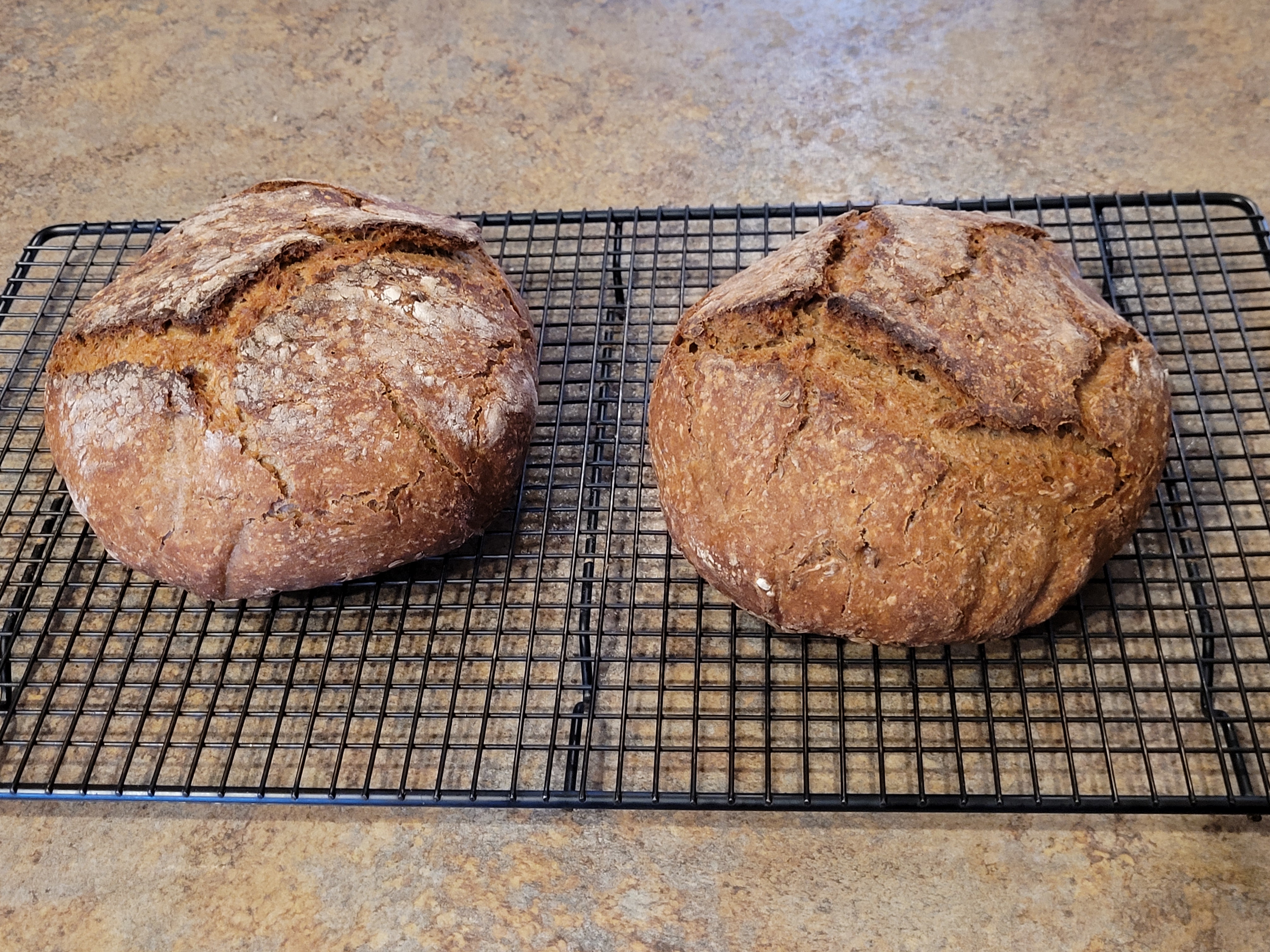
I had bought a couple cheap 2qt Dutch ovens off Amazon for bread-making.

- Joined
- Feb 19, 2017
- Messages
- 979
- Reaction score
- 1,238
Looks nice! What's your recipe for caraway pumpernickel?
Not sure if this is the right place to post this question but I am looking for an answer to a uh, MATH (?) problem.
Sometimes I want to (or have to) bake different size things I usually bake in other sizes... is there a formula to estimate a new baking time based on same shape but different size?
What is your experience baking things in different sizes?
Are there any general principals ?
Sometimes I want to (or have to) bake different size things I usually bake in other sizes... is there a formula to estimate a new baking time based on same shape but different size?
What is your experience baking things in different sizes?
Are there any general principals ?
Looks nice! What's your recipe for caraway pumpernickel?
Sorry, missed your post.
I just used this recipe from King Arthur, using the recipe's optional rye bread improver and just 1/2 tsp of the deli rye flavoring, as that is potent. Also added 2 Tbsp molasses and 2 tsp caraway seeds.
user 246304
Well-Known Member
- Joined
- Aug 24, 2017
- Messages
- 8,290
- Reaction score
- 9,850
Roggenliebling, recipe from Dr. Björn Hollensteiner.

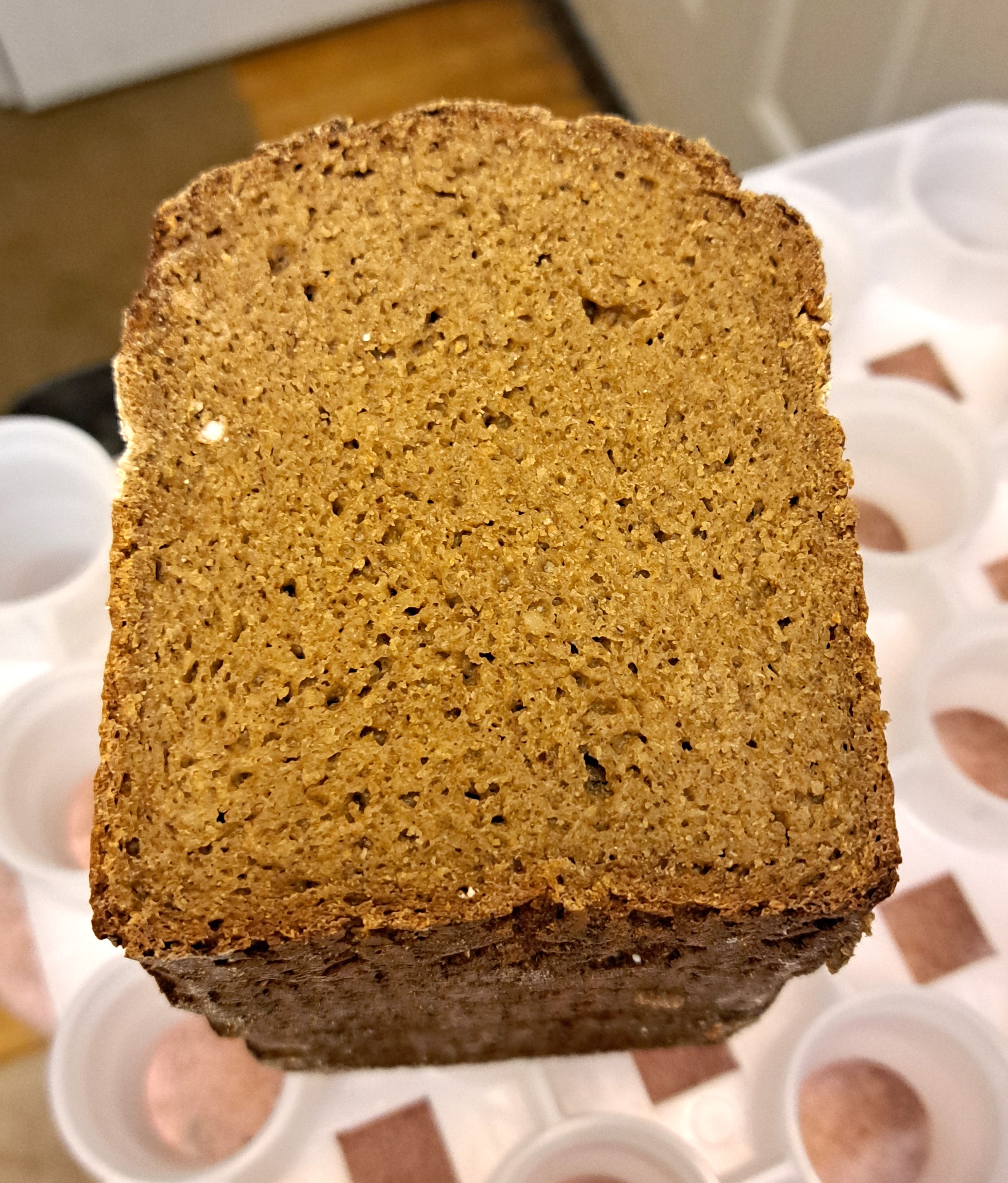
Mildes Kesseler, also from Björn ("mild," i.e., more wheat than rye; "würzig, "spicy," more rye than wheat. Both very traditional).

Kasseler, würzig.

Buttertoast mit Vollkornanteil:

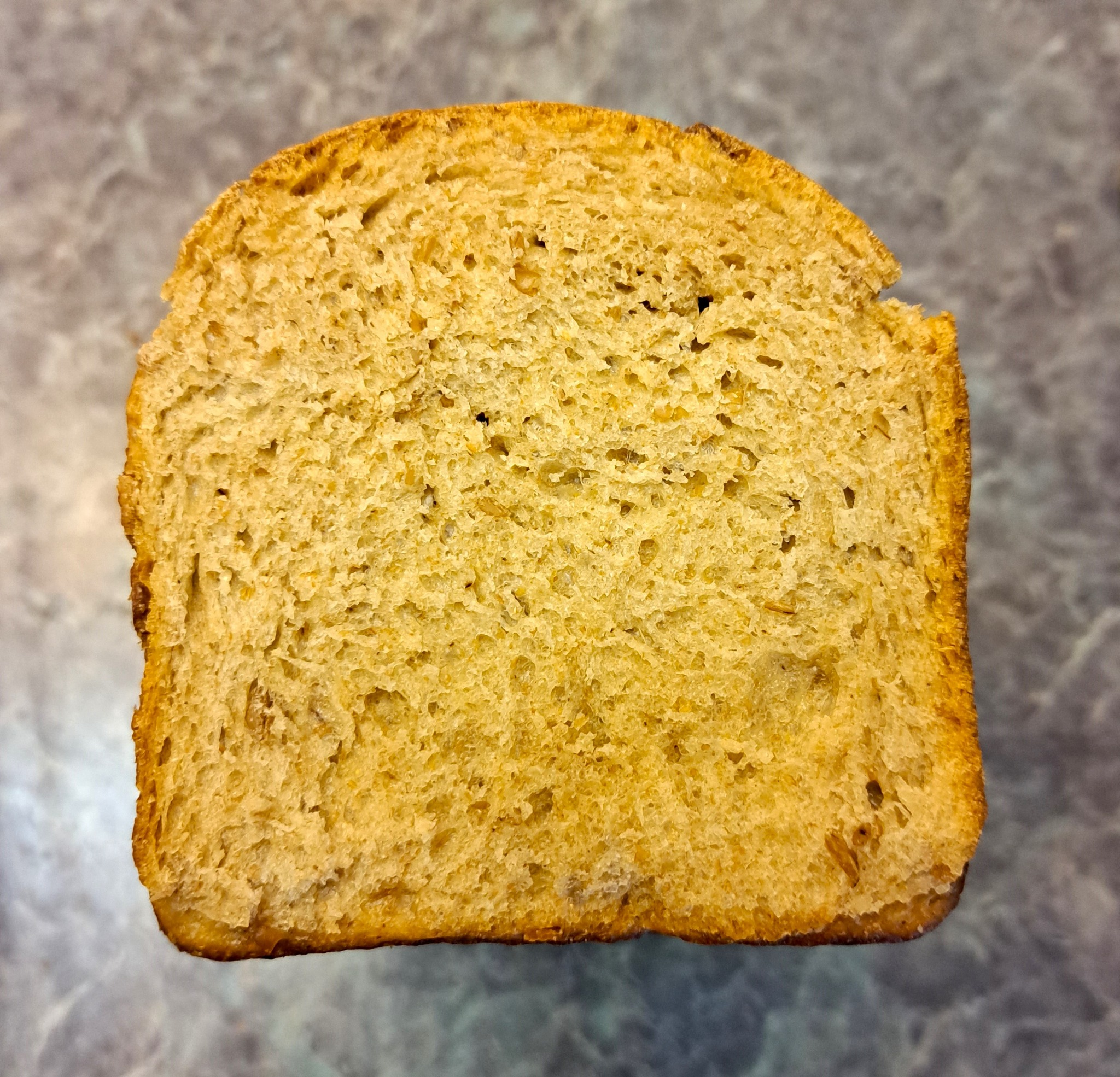
Ötzstler Saatenbrot.
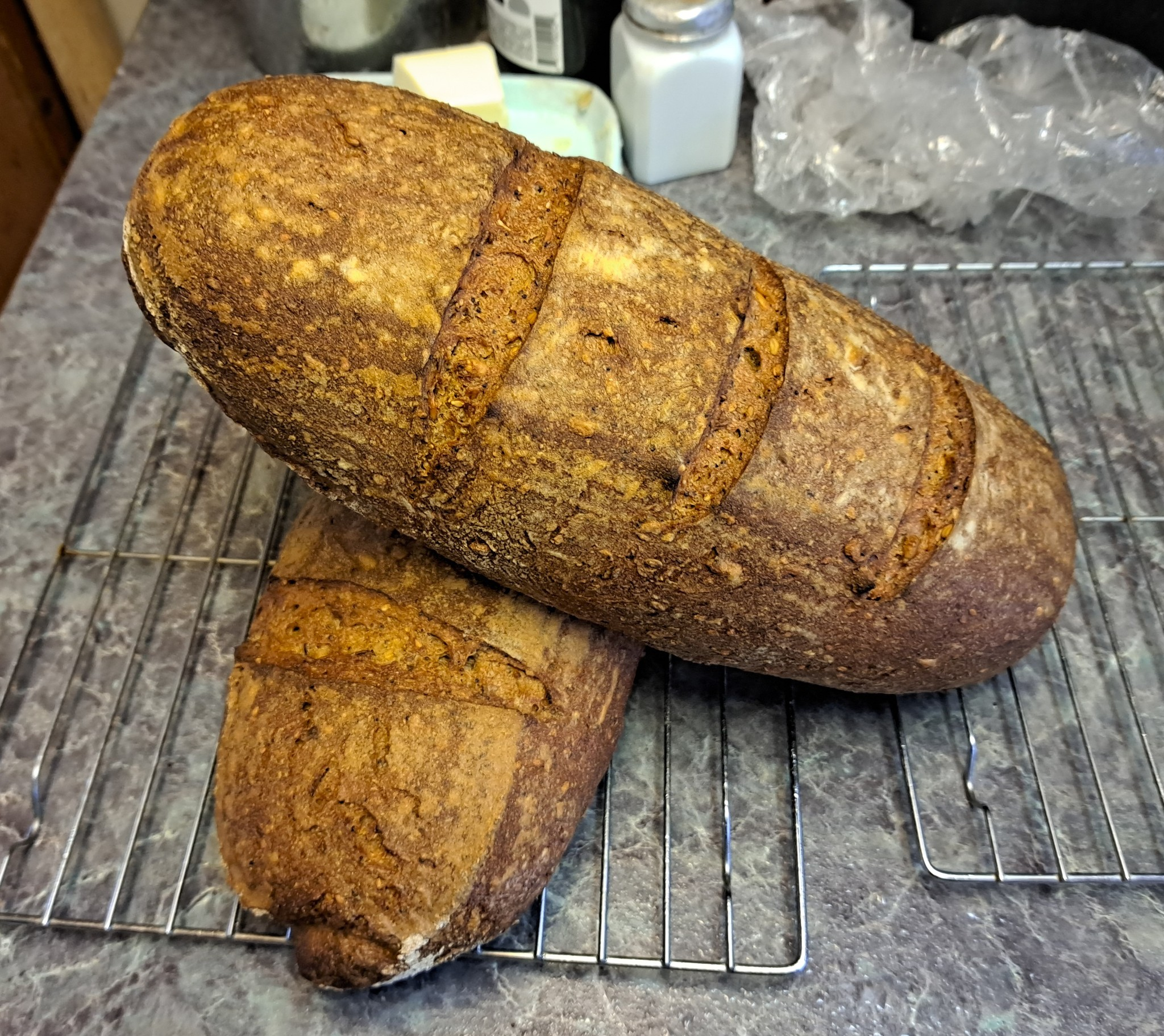

Weizen-Roggen-Sauerteigbrot. No proofing.
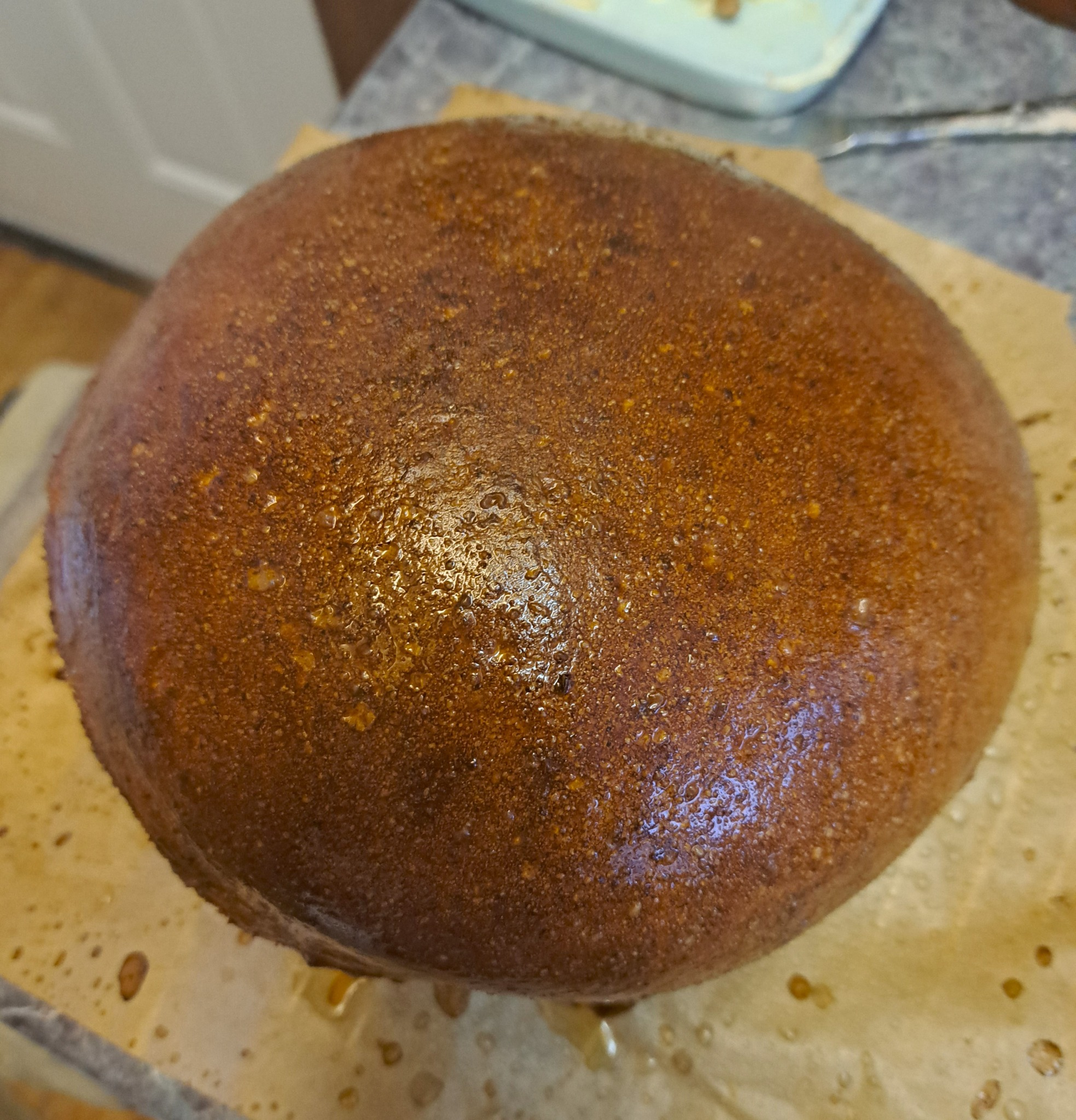
Swiss Farmhouse Bread - from Jeffrey Hamelman´s book, Bread. Hefewasser (yeast water).

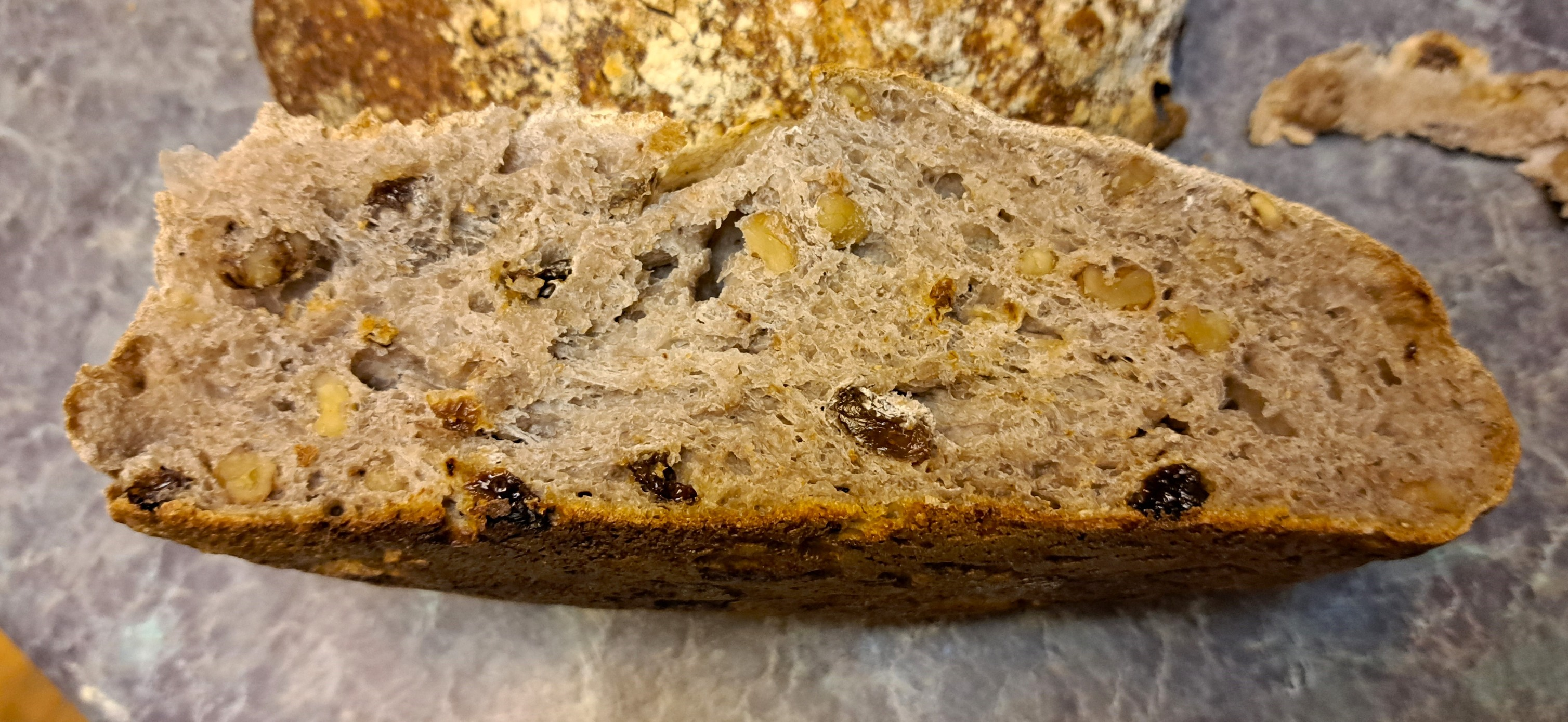
Pain de Campagne.

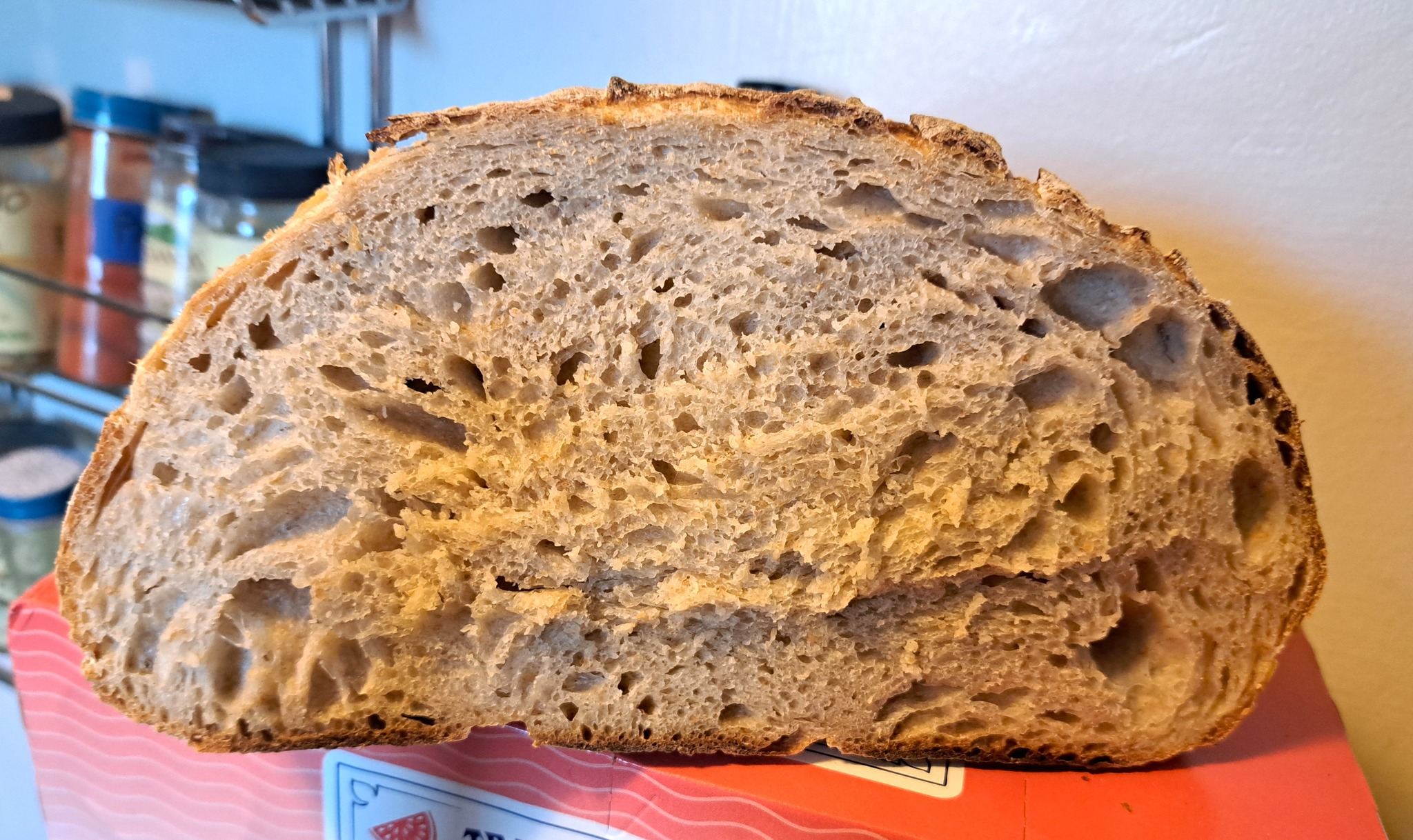
Mohnflesserl.

Frankenlaib.

Odenwälder Roggenkrüstchen.

I mill wheat, rye, spelt, emmer, kamut, einkorn and durum at home. This is a "Weizenkruste," wheat and einkorn.
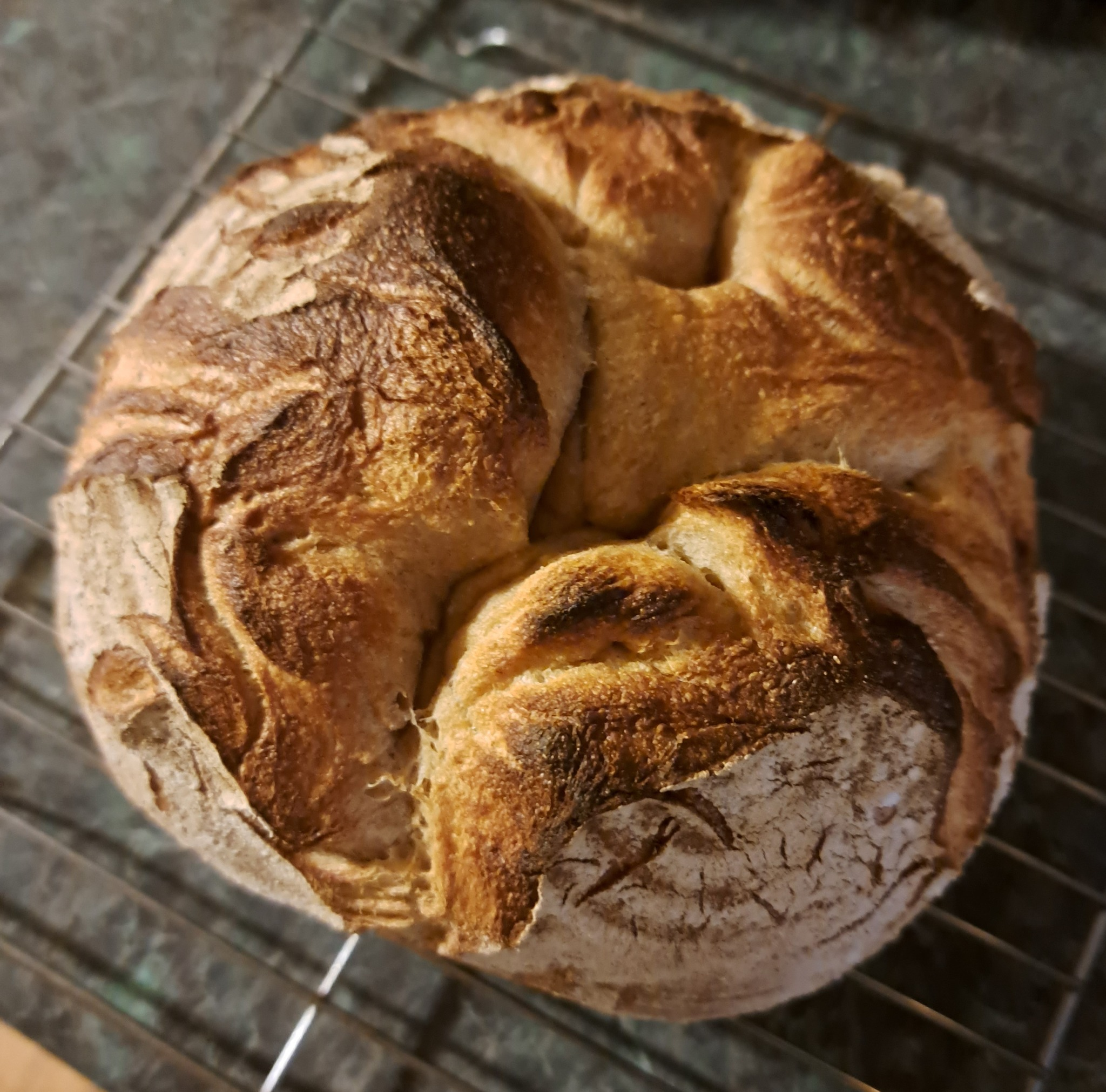


Mildes Kesseler, also from Björn ("mild," i.e., more wheat than rye; "würzig, "spicy," more rye than wheat. Both very traditional).

Kasseler, würzig.

Buttertoast mit Vollkornanteil:


Ötzstler Saatenbrot.


Weizen-Roggen-Sauerteigbrot. No proofing.

Swiss Farmhouse Bread - from Jeffrey Hamelman´s book, Bread. Hefewasser (yeast water).


Pain de Campagne.


Mohnflesserl.

Frankenlaib.

Odenwälder Roggenkrüstchen.

I mill wheat, rye, spelt, emmer, kamut, einkorn and durum at home. This is a "Weizenkruste," wheat and einkorn.

Last edited:
I’ve got a sourdough book which contains recipes for different sized loaves and the decrease in baking time between a loaf using 300 grams of flour vs 500 grams isn’t much. (10 minutes) I know this isn’t the answer you were looking for, but that’s about all I’ve got.Not sure if this is the right place to post this question but I am looking for an answer to a uh, MATH (?) problem.
Sometimes I want to (or have to) bake different size things I usually bake in other sizes... is there a formula to estimate a new baking time based on same shape but different size?
What is your experience baking things in different sizes?
Are there any general principals ?

This sourdough Pullman with 50% spelt developed a very crisp crust due to baking 20 minutes longer than expected before it was done in the center.
Thanks. I will take all the tips I can get! Baking infrequently makes this sort of skill elusive to master I think.I’ve got a sourdough book which contains recipes for different sized loaves and the decrease in baking time between a loaf using 300 grams of flour vs 500 grams isn’t much. (10 minutes) I know this isn’t the answer you were looking for, but that’s about all I’ve got.
View attachment 838666
This sourdough Pullman with 50% spelt developed a very crisp crust due to baking 20 minutes longer than expected before it was done in the center.

seeded Italian bread, conventional yeast.
user 246304
Well-Known Member
- Joined
- Aug 24, 2017
- Messages
- 8,290
- Reaction score
- 9,850
Looks excellent, congrats.View attachment 839434
seeded Italian bread, conventional yeast.
OMG, bring out the butter! That looks sooo tasty!View attachment 839434
seeded Italian bread, conventional yeast.

Sourdough loaf enriched with HB beer and peanuts.
user 246304
Well-Known Member
- Joined
- Aug 24, 2017
- Messages
- 8,290
- Reaction score
- 9,850
Couple from Daniel Leader's book Local Breads. A "Wiejski Chleba," "Polish Cottage Bread," really, a sourdough with mostly T 550 and Rye ASG; and Schiacciata all'uva or "Little Cheeks," little rolls with black olives, from Umbria, Italy. Can't open the Chleba as it's for a dinner tonight but the rolls, well..couldn't wait.






Oldskewl
Well-Known Member
At Thanksgiving my daughter was home from college and decided she wanted to start a sourdough starter from scratch. We tried a few things over the Christmas holiday, foccacia, sourdough bread and english muffins. All were decent but not great. I am learning that you need to get to know your starter and how it works with certain recipes as well as the temperature of the kitchen. Now she is off at college and I am left at home feeding this starter. LOL. I decided to try another foccacia bread recipe and I feel it turned out really good. I am sure the more experinced members on this thread can share some advice. I added green olives to half of it.
.
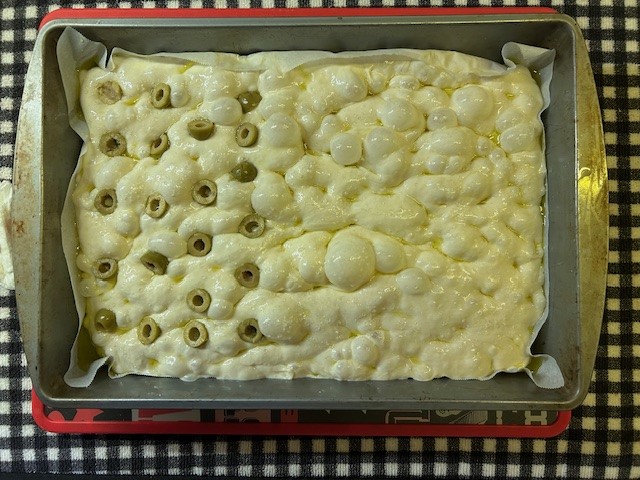



.




Your focaccia looks very good to me.At Thanksgiving my daughter was home from college and decided she wanted to start a sourdough starter from scratch. We tried a few things over the Christmas holiday, foccacia, sourdough bread and english muffins. All were decent but not great. I am learning that you need to get to know your starter and how it works with certain recipes as well as the temperature of the kitchen. Now she is off at college and I am left at home feeding this starter. LOL. I decided to try another foccacia bread recipe and I feel it turned out really good. I am sure the more experinced members on this thread can share some advice. I added green olives to half of it.
.View attachment 841106View attachment 841107View attachment 841108View attachment 841109
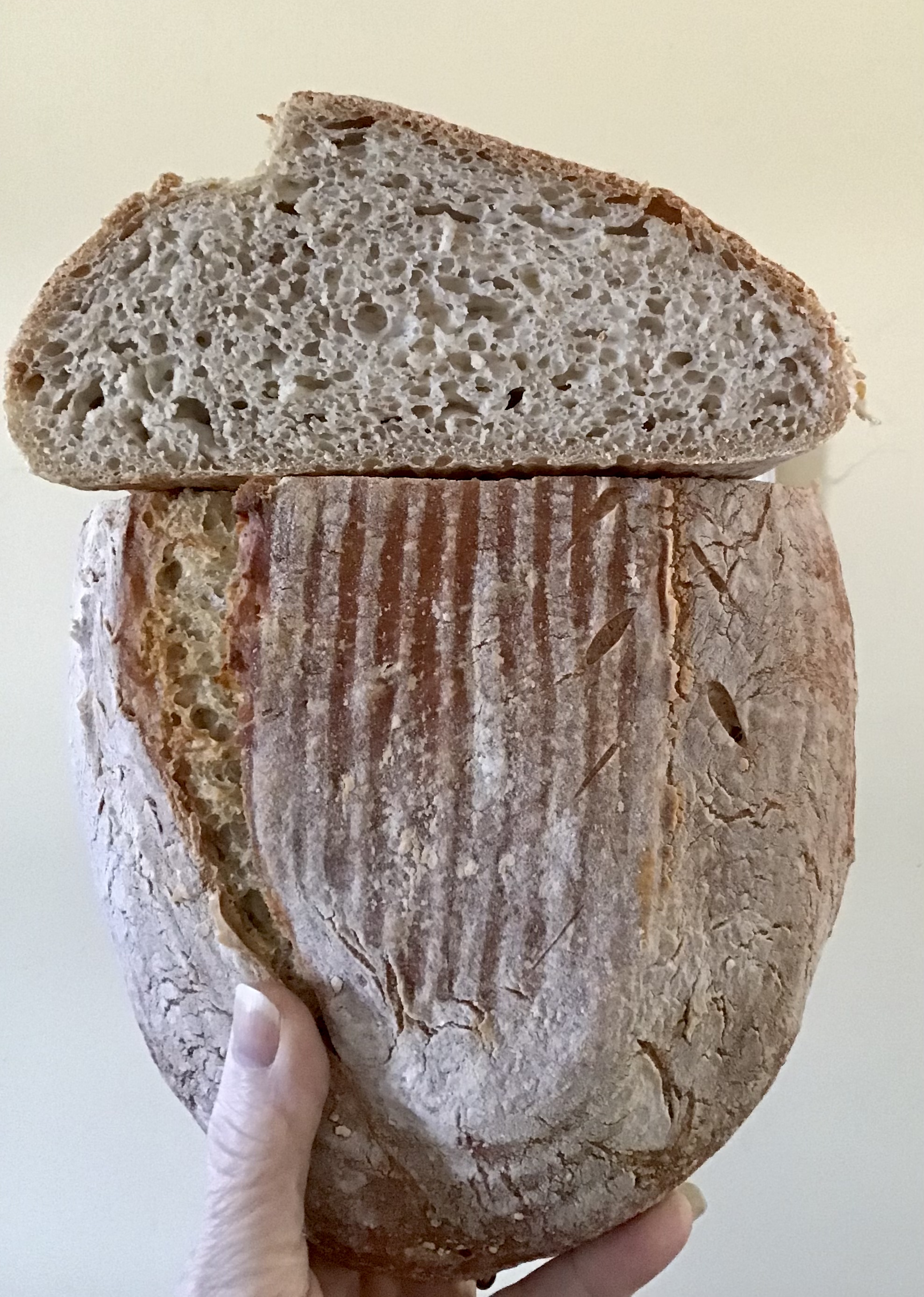
Sourdough made with potato water. It was a little over proved after 30 hour CR, but it baked up good enough.
user 246304
Well-Known Member
- Joined
- Aug 24, 2017
- Messages
- 8,290
- Reaction score
- 9,850
Looks excellent to me. Nice job!View attachment 841914
Sourdough made with potato water. It was a little over proved after 30 hour CR, but it baked up good enough.
Thanks, fingers were crossed.Looks excellent to me. Nice job!
user 246304
Well-Known Member
- Joined
- Aug 24, 2017
- Messages
- 8,290
- Reaction score
- 9,850
Type 85 wheat from Central Milling (74%)/home-milled whole emmer (26%) miche. 1641 g. Just out of the oven and cooling now, for breakfast tomorrow....and many meals thereafter. The miche is a large, rustic sourdough, traditionally baked in the village oven used in common and meant to feed a family for an entire week. It is also typically quite flat, relative to other breads.


Nice!
Sourdough sandwich loaf.




Just baked a couple mini-boules of pump rye. Will have some with the corned beef brisket simmering away in the slow cooker.



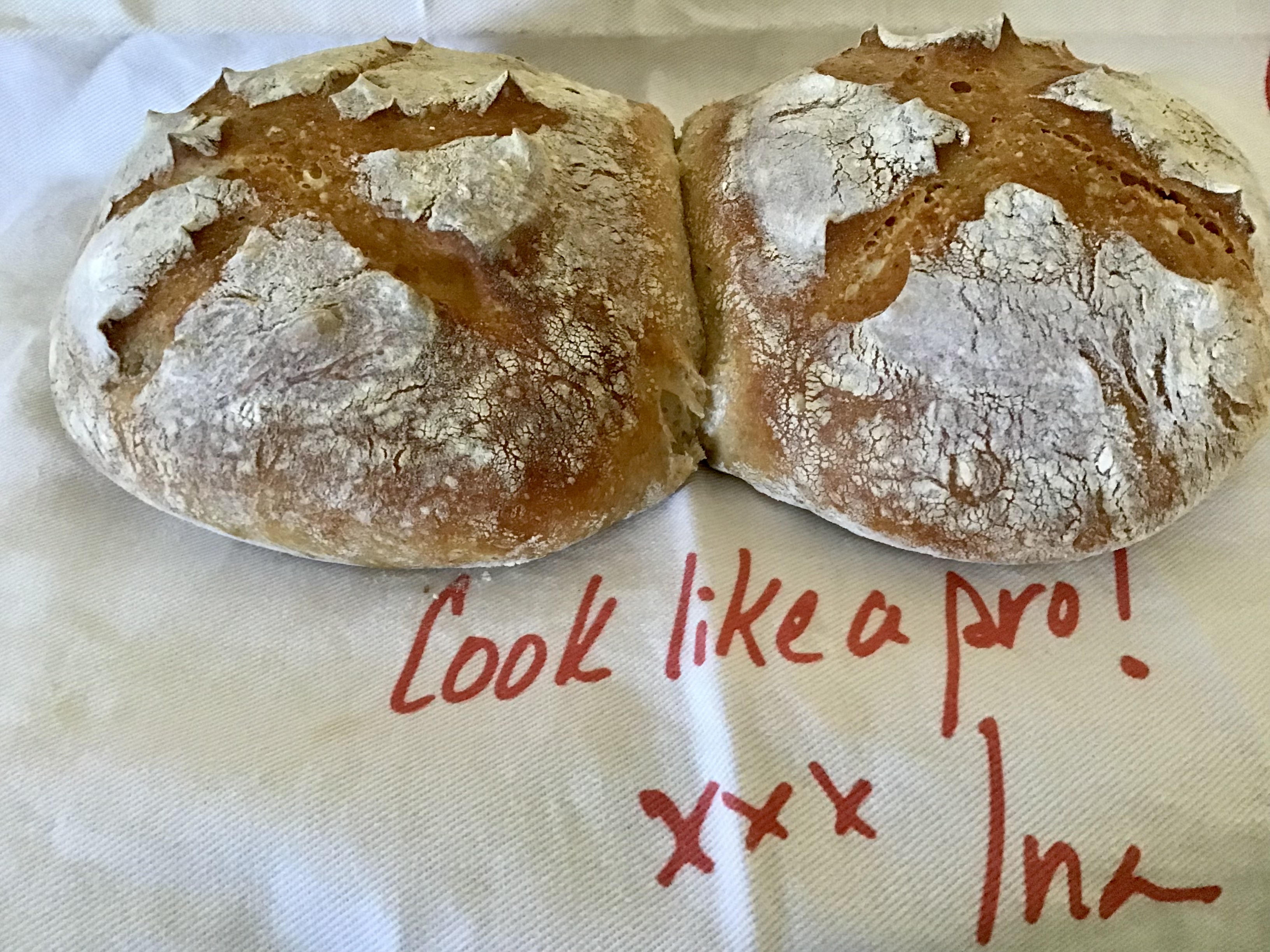
2 small boules for gifting. To safe time and energy I baked them in a medium sized enameled roasting pan. Unfortunately it was a little crowded, but that doesn’t change the taste. Used scissors to score as there wasn’t room to use the lame.
Oldskewl
Well-Known Member
Looks good Hoppy2bmerry! I am attempting my first sourdough loaf tonight. I hope it doesn't overproof while I am at work today. 
Oldskewl
Well-Known Member
I am happy with my first attempt at a sourdough bread. I had a hard time determining if it had risen enough when I got home. So I let it go another couple hours. I think it may have over proofed slightly. I had to make a ham, egg, & Swiss sandwich for breakfast. Yum!

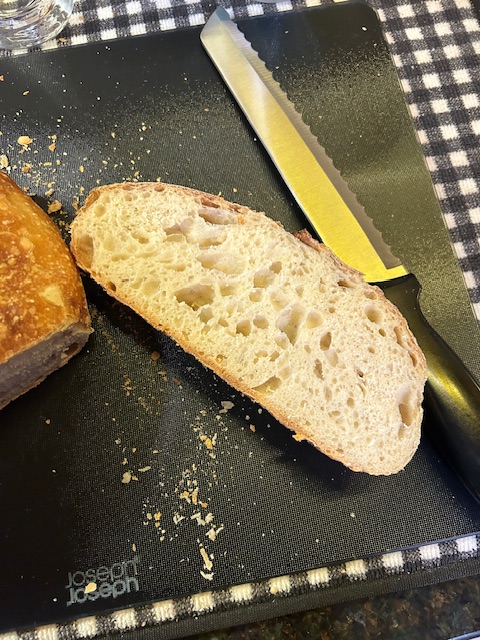




Attachments

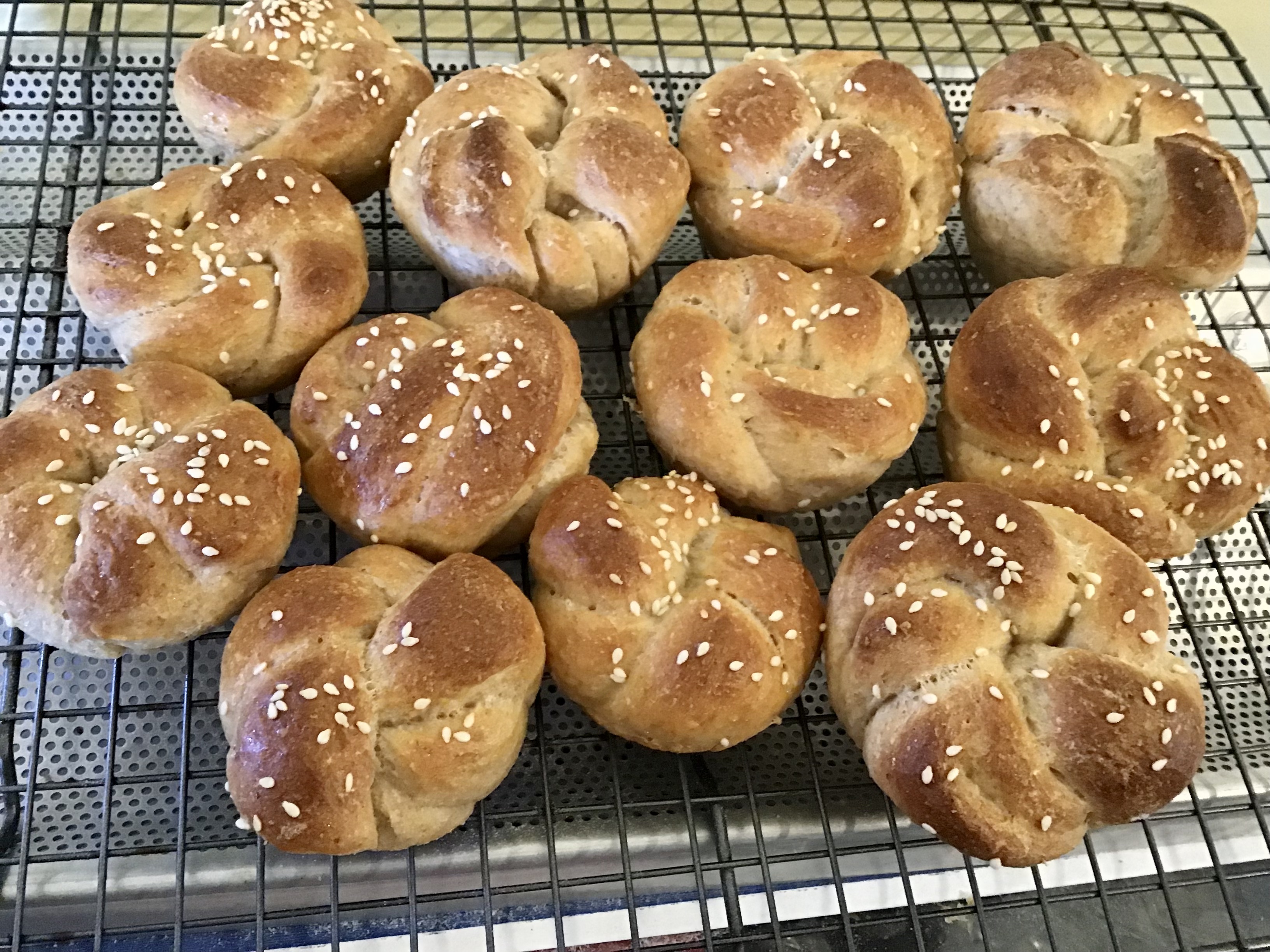
Enriched sourdough rolls. I don’t think I needed the muffin tins, but followed the recipe for the first go. Made with milk and honey they are wonderfully tender with the right amount of sweetness.
Similar threads
- Replies
- 7
- Views
- 1K
- Replies
- 4
- Views
- 1K











































